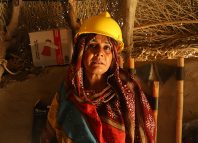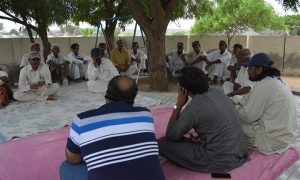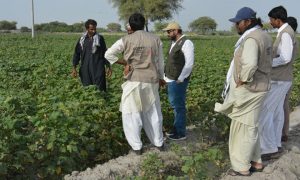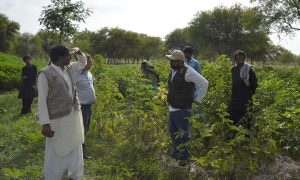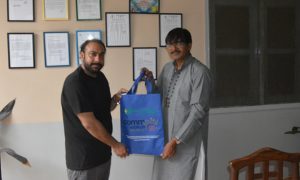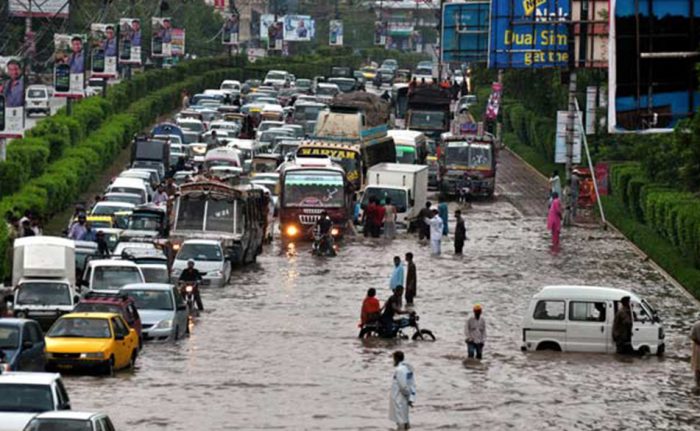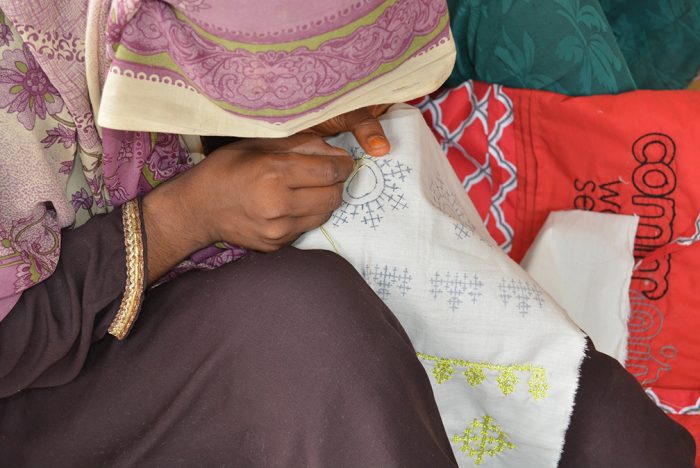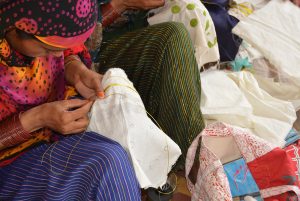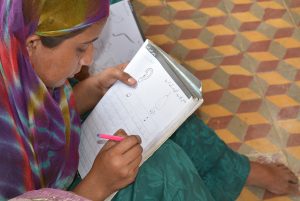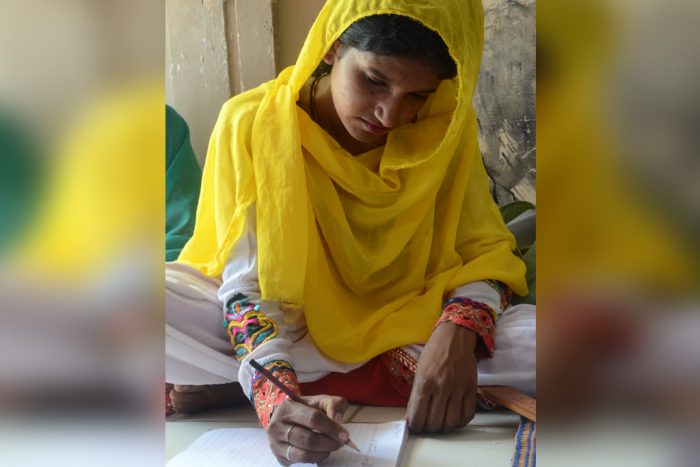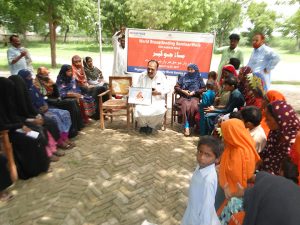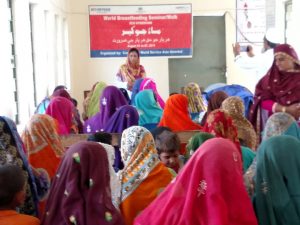| Duration | Sep 01, 2007 — May 31, 2008 | |
| Location | Keti Bandar and Kharochan Talukas of Thatta district in Sindh Provicne | |
| Key Activities |
| |
| Participants | Approx. 80,000 individuals |
Archives
Rehabilitation of WASH component for Flood affectees at Rajanpur
| Duration | Nov 15, 2008 — May 31, 2009 | |
| Location | Rojhan sharqi, Fatehpur, Noorpur mojahwala, Dajal, Wah lashari of Rajanpur district | |
| Key Activities |
| |
| Participants | 33,700 individuals |
Building disaster resilient communities through reconstruction of houses and capacity building of communities
| Duration | Sep 01, 2011 — Nov 30, 2012 | |
| Location | UC Bijora, Sujawal, Jaar, Keenjar of district Thatta | |
| Key Activities |
| |
| Participants | 13,856 individuals |
Improving Access and Quality of Education for Girls
| Duration | Jul 01, 2016 — Jun 30, 2017 | |
| Location | Thatta & Umerkot Districts, Sindh | |
| Key Activities |
| |
| Participants | 110 including teachers and students |
Collaborating with PDMA on Disaster Risk Reduction in Sindh
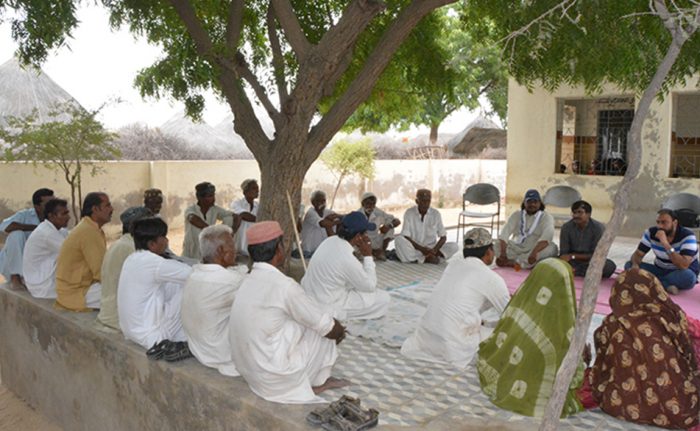
Community World Service Asia has signed a Memorandum of Understanding with the Provincial Disaster Management Authority (PDMA) in Sindh. The core components of the agreement focus on:
- Disaster Risk Reduction and Response
- Advocacy on Climate Change and Disaster Risk Reduction
- Quality and Accountability
Through this agreement, PDMA Sindh and Community World Service Asia will consort together on strengthening disaster risk reduction and response mechanisms in the province and advocating and acting together on climate change adaptation, emergency response, and relevant recovery activities to help Sindh’s disaster affected communities.
Ajay Kumar, Assistant Director Operations of PDMA Sindh, with his team, conducted a field visit to oversee the projects in Sujawal, Badin, and Tharparkar districts this August. The team first visited a community-level Emergency-Operating Center (EOC) and met with the Disaster Management Committee (DMC) established in Rahim Dino Thaeem, a village in Sujawal. The committee briefed the functions of the DMC and Emergency Operation Center. Ajay Kumar suggested that the EOCs needed to be linked with each other as well as connected with the district EOC through a wireless system. Community World Service Asia assured to work on the suggestion and analyzed how this would further strengthen the role of the EOC in the community.
PDMA Sindh team then visited Community World Service Asia’s Food Security and Livelihood project in Abbas Thebo, Badin. There, their team along with our staff, me the farmers, enrolled in the project supported, Farmer Field School (FFS). FFS promotes sustainable agricultural practices. It examines most appropriate methods of irrigation water use, role of Macro and Micro Nutrient trends in plants growth, weed management, land preparation, sowing methodology, demarcation of acres, and determining seed quality.
Abbas Thebo farmers shared that the involvement in FFS has enhanced their working capability in the agricultural fields. Approximately 12,000 fruit and forest trees have been allotted to and planted by the farmers, and kitchen gardening kits were distributed to women-headed households. Farmers participated in different festivals including the Farmers Festival recently held in August and took part in exposure visits to increase their knowledge on the subject.
The team’s next stop was at Baghtani village in Chachro, Tharparkar where they met drought affected families supported by PDMA Sindh in 2015. The Baghtani community still remembered the team members and praised the organization for visiting the village again. They told PDMA Sindh that its’ food assistance, given every seven months during the drought in 2015, helped the villagers survive the peak of the drought season. The food rations received were sufficient in quantity for their families. The community these days is very grateful to the rains they have received as it has brought their rain-deprived homeland some relief.
Upon the end of his visit, Ajay Kumar expressed,
“I commend the efforts of Community World Service Asia’s field team and the opportunity given to me to meet communities that have benefited from the various projects. It was nice to observe the enhanced capacity of communities in disaster risk reduction, early warning, sustainable agricultural farming, and strengthening of community institutions. This will all ultimately help communities to depend less on external support.”
Securing the lives of future generations through DRR
 Nisar Ahmed Memon, a 43 years old headmaster at the Government Boys Main Sindhi Chandia School, in Sujawal, Sindh, has always been passionate about bringing change through education. With this resolve, he joined the field of teaching in 1992 and has since then been engaging children to learn through play and active learning.
Nisar Ahmed Memon, a 43 years old headmaster at the Government Boys Main Sindhi Chandia School, in Sujawal, Sindh, has always been passionate about bringing change through education. With this resolve, he joined the field of teaching in 1992 and has since then been engaging children to learn through play and active learning.
The training focused on six disasters; earthquake, fire, flood, heavy rainfall and cyclone. Sessions on measures to take pre, during and post the various disasters on minimizing its destruction and the after effects were conducted. Being the first training of its kind, teachers and students at Nisar Memon’s school showed keen interest and enthusiasm in learning through group and drill activities.Community World Service Asia visited our school in 2015 introducing the DRR component under the Christian Aid supported project. I was instantly interested in the idea as it was a new concept and people in a rural area like Sujawal were not aware of disaster management before. We shared our profile with the team and a Disaster Risk Reduction Training was organized. Two DRR trainings were held for two consecutive years starting in 2016. Fifty students participated in each training. Participants were taught to analyze and build on knowledge to identify and prepare for major disasters and on how to cope afterwards. These skills were particularly important given the large-scale flooding that Sujawal experienced in 2010 damaging many of our houses, crops and savings.
As an outcome of the training, DRR groups were formed at the Main Sindhi Chandia School. With six groups in total, two students from each class were selected to represent as members in the groups. The groups have been divided as Flood Group, Cyclone Group, Fire Group, Earthquake Group, First Aid Group and Planning & Coordination Group and each group has a representation of fifteen to twenty students. A faculty member is assigned to each group to supervise them. These groups then train other students on specific DRR practices so that the knowledge is shared with everyone in school. Every week, these DRR groups brief students of a selected classroom on possible natural hazards and the measures that need to be taken. A drill activity is conducted as a demonstration for the students to clearly understand the measures, use of equipment and their role if any such emergency situation arises. All students get the opportunity to equally participate in the drill activities, enabling each student to apply their knowledge on DRR to real situations.
In school curriculums, the topic of natural disasters is touched upon under the subject of Social Studies but that does not provide students with DRR related knowledge or skills. Nisar Memon has introduced drill activities as part of the teaching curriculum supporting the Social Studies lessons on disasters.We encourage students to share their learning at homes as well which enhances their understanding and strengthens their involvement in the community. In addition, the whole school, including teachers and students, are aware of the six main disasters and the measures to be taken. This is a great achievement for us as an institution because in rural areas this kind of skill development is not generally found.
explained Nisar.After covering the chapters on natural disasters, the teachers then engage students in drill activity of the disaster taught, which allows students to develop a complete understanding of the disaster and of the measures that need to be taken when it occurs,
A DRR Carnival was organized to provide an opportunity to young children to present their DRR work. The main purpose of the event, celebrated on 25th May, 2017, was to engage teachers and students from different schools to hear about their experiences; how they implemented DRR in their schools and how it contributed to making their schools safer.
A total of five hundred guests, including students and teachers from various schools, government officials and other stakeholders, actively participated at the event. DRR themed paintings made by students of GBPS Main Sindhi Chandia, Sujawal were also on display.Our students participated in the event with great enthusiasm. They prepared plays and skits to perform at the carnival which displayed various disasters and the role of men, women and children in tackling these disasters to reduce loss.
The active headmaster, Nisar Memon, also participated in a four-day training on Emergency Preparedness and Contingency Planning which was conducted to train government and other relevant institutions staff on effective DRR methods.
Falak Nawaz from Network Of Disaster Management Practitioners (NDMP), lead facilitator at the training, conducted an effective and productive training which enhanced our knowledge on international strategies for Disaster risk reduction and contingency planning. We were briefed on the difference between contingency planning and disaster risk management planning. In addition, we were oriented on the importance of contingency planning.
Students in rural areas readily welcome whatever new learning opportunities they are offered as it allows them to further enhance their knowledge, intellect and skills.
Students are trained to react accordingly to different disasters and escape routes are identified. The disaster groups are actively involved with students on how to respond to emergencies on a weekly basis. This has enriched the knowledge and developed DRR skills of around 850 students in the GBPS School.We have displayed a school map in the school which shows different exits and placements of various equipment that are to be used in times of various disasters. We have hanged bottles filled with little sand outside some classrooms. In case of no warning, the movement of the bottles will indicate earthquake or strong winds of cyclone. This way the teachers and the students will be able to take immediate measures required for the safety of all. In addition, fire extinguishers are placed in the school premises and their locations displayed on the school map. We want to ensure maximum safety of our students therefore we implement brief revisions of the map and drill activities on a weekly basis as well. We have also installed emergency bells which will ring at the time of the disaster to alert everyone in the premises.
expressed Nisar contentedly.In future, these children will grow up and be in different places. If any disaster occurs, they will be able to protect themselves and the communities around them. This thought motivates me everyday to further work on this cause,
With more of these trainings and DRR activities conducted in school, the interaction between teachers and students has increased, strengthening their relation and building student-teacher trust. Many students at the school were afraid of their teachers at first and were hesitant to express themselves. After participating in the training and drill sessions, students have become more expressive and vocal with the teachers, making the learning environment in school more friendly and productive.
I am happy to announce that our enrollment has increased from 723 to 850 students in just a year. Our students and teachers have shared their learning and experiences at homes and communities. This has raised our standard of learning which has attracted many parents to enroll their children in our school. The families completely trust us with their children.
Recalling the floods in 2010, Nisar shared that most of Sujawal drowned in the floods. By the time the flood warning was announced, many women and children had already drowned in the rising waters as preparedness measures were not in place and there was no awareness on DRR.
As the schools reopened after the flood water receded, families feared to send their children to schools. The interest in education decreased due to the overwhelming fear of the floods. Similarly, they feared of other disasters like earthquakes and cyclones hitting their homes and villages. This DRR initiative has increased the confidence of students as well as their families. They are fully aware on how to react when a warning is announced and at times of emergency situations.
beamed Nisar.Lives are secured and that is a great improvement on its own. We have started a continuous process as these children will grow up and have families one day. They will share their knowledge with their children. This initiative will save lives of generations to come,
Situation Alert: Widespread showers lash Sindh’s southern and central districts: Coming rains predict even more floods and damage
Photo credit: www.thenews.com.pk
Monsoon rains continue to lash the city of Karachi and other districts in southern and central parts of the province. So far thirteen people have been reportedly dead, mostly due to electrocution. Rain water is rolling into most of the city like gushing streams. Most residential areas and houses are partly submerged in water and drainage canals and tributaries are overflowing. Side-roads on the main Karachi highway have also been washed away and are completely under-water.
Moreover, a 150-feed breach in the Thado dam, in Karachi, has resulted in thousands of cusecs of water pouring out and flooding nearby areas and towns, housing more than 6000 residents.
This rain water has inundated many urban and semi urban towns of Hyderabad, Sanghar, Tando Muhammad Khan, Badin, Thatta and other districts, in ankle-deep water.
The Deputy Director of the Pakistan Meteorological Department (PMD) released a statement indicating that there may be high chances of urban flooding in most parts of Karachi due to the city’s poor drainage system. Heavy downpour has wreaked havoc in the city, leading to most roads being submerged in water and the civic infrastructure crumpled.
The PMD has predicted more rains on Friday and Saturday, which may lead to the situation further deteriorated.
Community World Service Asia Response: Community World Service Asia is monitoring the situation and is in contact with the local authorities on updated information. The emergency response team of Community World Service Asia is on standby and will be deputed immediately if the need to respond to the crisis arises.
Contacts:
Dennis Joseph
Associate Director – Disaster Management Program
Email: dennis.joseph@communityworldservice.asia
Cell: +92 300 855 7414
Palwashay Arbab
Head of Communications
Email: palwashay.arbab@communityworldservice.asia
Tel: +92 42 3586 5338
Sources:
www.samaa.tv
www.tribune.com.pk
www.express.tv
www.Dunya.tv
www.geo.tv
Three hundred new artisans enrolled for skill building in Umerkot
Community world Service Asia’s livelihoods and women empowerment project, supported by YCARE and UKAID, in Umerkot district has initiated its third year this April. The activities under the project aim to empower local women with a sustainable increase in their household income through enhancing their handicrafts skills and connecting them with markets, among the many other components of the project. This year, three hundred new artisans have been selected from nine new villages in Union Council Karroo Syed and Sabo this year.
A six months training was designed in two phases, each of three months, on Skill enhancement and Product Development with the expertise of designers from Indus Valley School of Arts and Architecture (IVS) Karachi.
The designer identified six main stitches for skill development, namely Kacho, Pako, Muko, Chain, Kharak and Hurmuch. During the first three months of the training, stitching and embroidery skills of local artisans’ part of the Women Enterprise Groups (WEGs)[1], were enhanced. The skill building mainly focused on building upon the traditional skills that these women already had but in more accordance to latest fashion trends and market demand, which were lacking in their previous home-made products. These skill enhancement classes were organized by Community liaison officers (CLOs) and mentored by Enterprise Development Officers (EDOs) of Community World Service Asia.
In addition, artisans were also taught the value addition of using the right color combinations, designing and cuts and quality control- all aspects which are pivotal to the urban buyers. For budgeting, pricing and dealing with customers, the artisans were given a three months training on adult Literacy courses which enabled them to read, write and compute during their business dealings.
The determined women from Umerkot are currently practicing their newly acquired skills by working on test products using modern designs and fashionable color schemes. This will particularly allow artisans to improve their quality of work and design which will increase the value and exclusivity of their handmade products.
[1] Women Enterprise Group is group formed of rural artisans, producing hand-made products, in the vocational centers established in various villages of Umerkot.
One family’s leading role in empowering an entire village
Akhtawar, is a 19 year old artisan who dreams to become a professional handicrafts manufacturer. Belonging to Raeem Dino Thaeem village in Thatta, Akhtawar lives in a joint family system, with eighteen members living in one house. Five of them her own siblings.
My elder brother is a teacher at a private school located in Bello City. He earns PKR 1500 (US $ 15 approx.) a month. He is also a member of the Gender-based violence (GBV) and Sexual and Reproductive Health (SRH) theater groups formed in our village. He earns PKR 1500 per day for his performances. Our father is an agricultural farmer, harvesting crops including wheat and rice. He owns the land but buys seeds on loan as he cannot afford to buy them. This way the loan is returned in the form of harvested crops. Most of the harvest is given to the seeds seller in order to repay the loan.
Community World Service Asia’s and Christian Aid’s livelihoods project came to Raeem Dino Thaeem village with an aim to empower the local women and assist them in earning a better living by enhancing their inborn skills of stitching and embroidery. To initiate the project, an assessment test was conducted to select artisans for the vocational trainings. Many women from the local villages took the tests to be selected. Akhtawar was amongst those who passed the assessment test and was selected as a participating artisan under the enhancing livelihoods project in Thatta.
The three month Adult Literacy Training enlightened many uneducated women in the village. I passed my matriculation but some women at the centre had never received any schooling since their families could not afford it . They could barely afford their household and medical expenses. The literacy training enabled the artisans to learn basic Mathematics, English and Urdu. Many of the artisans wrote their names for the first time in English. My aunt also received the literacy training and she used the learning to teach her own school going children at home. I also teach my younger brother and sisters. I even teach my mother who learns as eagerly as my siblings. My uncle was so pleased to see how well we read and understand the course books.
Before the trainings, Akhtawar stitched clothes at home without the use of any sewing tools.
It was at the skill development training that we learnt to use sewing tools. We usually measured the clothes directly on the body and cut accordingly. Therefore the fitting of the clothes was never accurate. We learnt to use measuring tapes at the skill development training at the center. The quality of my stitching and apparel fitting improved immensely. On the other hand, we learnt new designs and threadwork which enhanced our embroidery skills bringing variety to our work and increasing its value.
Akhtawar has received many personal orders from neighbours and other residents of nearby villages since she graduated from the training centre. Young and determined Akhtawar has already worked on completing orders for some of Pakistan’s famed fashion designers such as Shayan, Imrana from Indus Valley Schools of Arts and Architecture (IVS), Habitt, Najia and Nida Azwer.
I have earned an estimate amount of PKR 8000. My mother is ill and requires medicines at all times. After some tests, the doctor told us that my mother’s brain is weak and prescribed some medicines. The expense of travelling to the hospital in Tando Allah Yar and tests were all borne by me. This made me very emotional as I never thought I would ever be able to help my family this way. In addition, I also paid the admission fees of PKR 1000 for my brother’s English Language course for which he travels to Bello City. I also contribute to his monthly school fees which of PKR 500.
According to Akhtawar, the input and participation of women in their village has mostly been limited to their homes. The only way they sometimes contributed was through farming which is exhausting during the scorching sun in the day. T
he crops we harvested or the money earned through the sale of the crops was mostly paid off in loans, so very little was saved for the family to use. The vocational center enabled me to contribute to my family of eighteen members. I proudly contribute in the household, education and medical expenses and my parents and siblings are pleased with my growth and financial independence.
Akhtawar’s elder brother and sister, Rahim and Bakhtawar, are members of a theater group as well which performs to raise awareness on issues of SRH/GBV.
Many men in these communities are conservative but many have gradually started engaging and participating in the theatre plays as performers and spectators.Initially my father did not support the idea, but when he attended some performances and witnessed the change in the rigid minds of many villagers, he too supported my siblings in their work.
I watched the first theater performance in November last year when the group performed in our village. The men in the village were surprised to know how young girls’ health are badly affected by child marriages. They were not aware of the health and mental issues a young girl goes through when married early. I was astonished to see the change in men when they refused to marry their young daughters after watching these plays. Today, many encourage their daughters to join schools or vocational centers in order to build a better future for themselves. In addition, mothers’ consent started being taken before entertaining marriage proposals for their daughters.
Both of Akhtawar’s parents fully support their children in actively participating in activities that are helping to bring positive changes in their community and society. Akhtawar shared that girls in her village did not travel faraway places for any reason.
Ali Hassan (Akhtawar’s father has been supportive towards bringing positive change as he believes in educating people who have not been fortunate enough to gain such opportunities.My father permitted Rahim and Bakhtawar to attend the SRH/GBV training in Hyderabad for 10 days. He encouraged them to bring back knowledge and new learnings which will enlighten the conservative minds of the villagers.
openly expressed Akhtawar.Life has changed a lot since our involvement in the livelihood project. I work as an artisan and my brother and sister are part of the theater group. We also travel to attend trainings whenever we get an opportunity. This initiative has given a new meaning to our lives. Girls were caretakers of their home and this was the concept we were living by. But after theater performances and women working in the vocational centera, women have realized that, like men, they can also earn and support their families, and live a better life. Women can also go out in the world and explore opportunities to have a better future for them and their children,’
Seminar on the benefits of breastfeeding for women in rural Sindh
A seminar promoting breastfeeding among local communities in rural Sindh was held during the World Breastfeeding week at the three Rural Health Centres, supported by Community World Service Asia and Act for Peace. A large number of community members consisting of women and men and government health department officials took part at the various sessions of the seminar at the RHCs in Hyderfarm, Nabisar and Dhoronaro. The seminar was facilitated and sessions were delivered by experienced Medical Superintendents (MSs) and Community World Service Asia health team on the importance and benefits of breastfeeding. This was organized to encourage more and more women to breastfeed for longer periods and to not consider it a taboo.
Key points highlighted at the seminar were:
- WHO recommend that babies are exclusively breastfed for 6 months and solid foods are started after that, along with continuing breastfeeding for two years and longer
- Breastfeeding provides the ideal amount of nutrition for infants. It is a perfect combination of vitamins, protein and fat – everything that the baby needs for a healthy development
- Breast milk consists of antibodies that help babies fight viruses and bacteria
- Babies who are breastfed exclusively for the first 6 months without being given any formula milk are less prone to infections and illnesses
- Breast milk is easily digestible and is also known to be a contributing factor towards higher IQ scores later in childhood
- Breastfed babies are considered to have a healthy weight with less chances of obesity later on
- Breastfeeding also helps the mother to lose pregnancy weight faster




